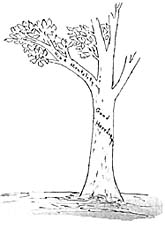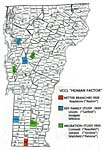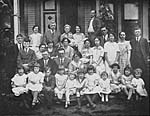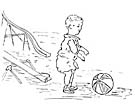

 1928-1931 The Vermont Commission on Country Life: "Pride in Place & Ancestry"
1928-1931 The Vermont Commission on Country Life: "Pride in Place & Ancestry"  The Human Factor studies of the "People of Vermont," in contrast, focused
on the social forces that had contributed to the rural exodus and discouraged
large families among the "good old Vermont stock." The Eugenics Survey's Key
Family Study and Migration Study presented family profiles of pride and celebrated
the achievements, community spirit and endurance of Vermonters in the face
of a changing economy. The eugenic core of the VCCL emerges in their recommendations:
The Human Factor studies of the "People of Vermont," in contrast, focused
on the social forces that had contributed to the rural exodus and discouraged
large families among the "good old Vermont stock." The Eugenics Survey's Key
Family Study and Migration Study presented family profiles of pride and celebrated
the achievements, community spirit and endurance of Vermonters in the face
of a changing economy. The eugenic core of the VCCL emerges in their recommendations:
It is clear that if the valuable characteristics of our old Vermont stock are to be conserved and passed on to future generations for the good of the state and the nation, conditions must be brought about which will favor the maintenance of that stock as far as possible. . . To promote the best future citizenry in the state, this Commission makes the following recommendations:1. That Vermonters be encouraged to keep and study their own family records with a view to arousing their pride in the achievements and high qualities of their ancestral stock so that this pride may in turn stimulate their better efforts and guide them in their choice of mates.
2. That the doctrine be spread that it is the patriotic duty of every normal couple to have children in sufficient number to keep up to par the "good old Vermont stock."
VCCL, Rural Vermont: A Program for the Future, "The People"
 For "Handicapped" Vermonters, whose family records and ancestral stock had
already been studied and stigmatized by the Eugenics Survey, the Commission
advocated an expansion of state programs in child health, education and welfare
and prevention of marriage and reproduction of "feeble-minded" persons. In
1931, the Vermont legislature became the 27th state to enact a sterilization
law. As Secretary of the Commission until 1931 and Executive Vice President
after 1931, Prof. Perkins used the VCCL as a venue to promote eugenics in
Vermont.
For "Handicapped" Vermonters, whose family records and ancestral stock had
already been studied and stigmatized by the Eugenics Survey, the Commission
advocated an expansion of state programs in child health, education and welfare
and prevention of marriage and reproduction of "feeble-minded" persons. In
1931, the Vermont legislature became the 27th state to enact a sterilization
law. As Secretary of the Commission until 1931 and Executive Vice President
after 1931, Prof. Perkins used the VCCL as a venue to promote eugenics in
Vermont.
 The VCCL records reveal the growing tension between genetic explanations
for social problems advanced by eugenicists and the preference for social
explanations of country life activists, educators, and social workers. Perkins
tried to reconcile the two, through classifying their studies as "eugenical-sociological."
Despite differences of opinion over the role of nature or nurture, a consensus
prevailed that the "handicapped" were unfit to conceive and raise children.
The VCCL records reveal the growing tension between genetic explanations
for social problems advanced by eugenicists and the preference for social
explanations of country life activists, educators, and social workers. Perkins
tried to reconcile the two, through classifying their studies as "eugenical-sociological."
Despite differences of opinion over the role of nature or nurture, a consensus
prevailed that the "handicapped" were unfit to conceive and raise children.
Continue to . . .